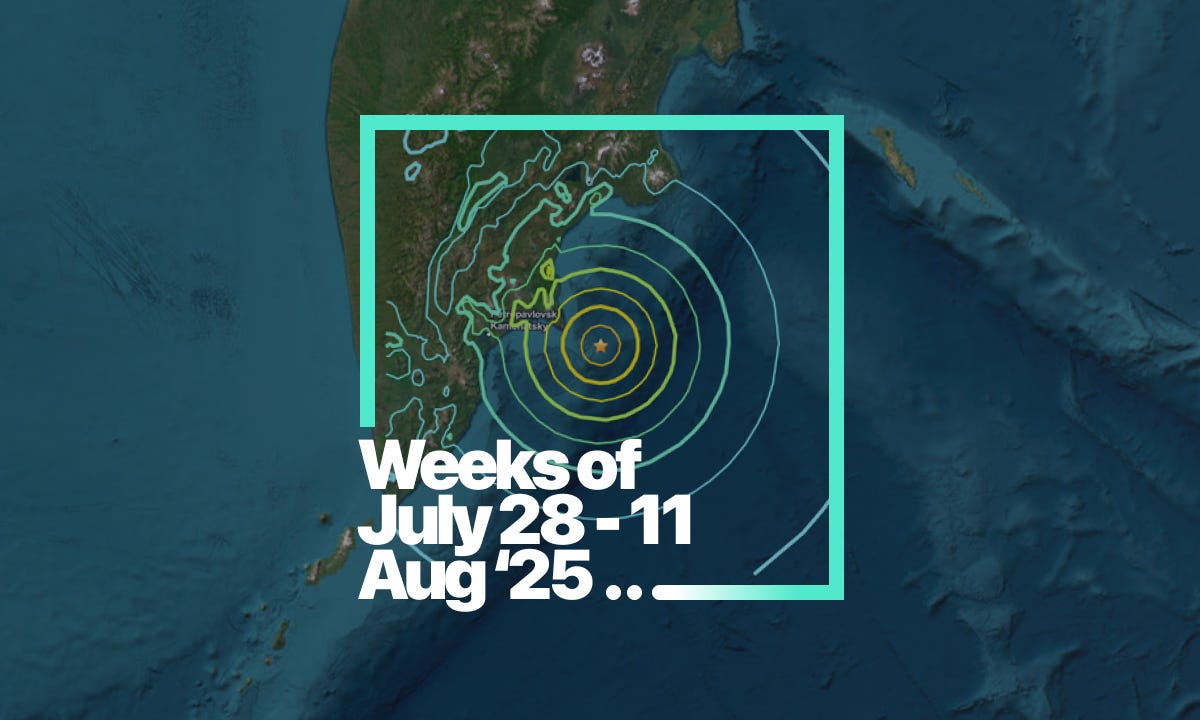Hello 👋 get a brew on because these are the top emerging risks between July 28th, and August 11th, 2025…
Review our report’s terminology here ↗
Our main risk this fortnight is…
1. Societal: Concerns in New Zealand as alarm system fails
New Zealand's emergency alert system faced severe criticism after 6:30 AM tsunami alerts sparked public anger over interrupted sleep rather than safety concerns.
Technical glitches caused some people to receive eight alerts while others received none, undermining system credibility.
Unlike Japan and Chile, which evacuated millions from the same threat, New Zealanders complained about the inconvenience.
The incident reveals deeper systemic problems including lack of universal warning frameworks, alert fatigue, and eroding public trust.
People are now disabling emergency notifications entirely, creating collective safety risks for entire communities.
Sources
NZ's early morning tsunami alerts - Expert Reaction | Science Media Centre | Science Media Centre | July 31, 2025
Tsunami alert glitch: Civil Defence investigates multiple early alarms | NZ Herald | NZ Herald | July 31, 2025
M8.8 Kamchatka earthquake and tsunami | National Emergency Management Agency | NEMA | August 2025
You should be concerned if…
You live in coastal New Zealand: The breakdown in emergency alert effectiveness particularly threatens coastal communities who rely on these systems for tsunami warnings. Technical failures during actual threats could prove fatal.
Your business depends on emergency communication systems: Companies that rely on emergency alerts for crisis management or have operations in disaster-prone areas face increased operational risks as public trust in official warning systems erodes.
You operate in regions with aging emergency infrastructure: Areas with underfunded or technologically outdated emergency management systems may experience similar trust breakdowns, leaving communities vulnerable during actual crises.
These items are generic assumptions. We recommend considering your own unique risk landscape against your critical dependencies. If you don’t know what they are, get in touch.
Preventative actions
Diversify Emergency Information Sources
Don't rely solely on official mobile alerts, maintain multiple information channels including radio, local news, and social media monitoring to ensure you receive critical warnings even if one system fails.
Test Personal Emergency Protocols Regularly
Establish clear evacuation procedures for your household or business and practice them quarterly, ensuring all family members or staff know response protocols regardless of how they receive emergency information
Engage with Local Emergency Management
Participate in community emergency planning sessions and provide feedback to local Civil Defence groups about alert system effectiveness—active community engagement helps improve system reliability and builds trust
2. Technological: AI Disruption in Financial Markets
Investors are actively fleeing stocks of companies feared to be vulnerable to AI disruption, with some dropping 33-50% in value this year.
Bank of America has identified 26 companies most at risk, including web development firms, digital image companies, and advertising agencies..
The timeline for AI disruption has compressed from an expected five years to potentially just two years
Service-based businesses with high headcount are particularly vulnerable to AI automation.
Major companies like Adobe, Wix.com, and Shutterstock face declining valuations as investors bet on AI replacement technologies.
Sources
Traders Are Fleeing Stocks Feared to Be Under Threat From AI | Bloomberg | Bloomberg | August 9, 2025
Wall Street's Next Crash Won't Be Human-Induced: The Looming Threat of AI-Triggered Market Meltdowns | Risk & Insurance | Risk & Insurance | May 7, 2025
Artificial Intelligence Can Make Markets More Efficient—and More Volatile | IMF | IMF | October 15, 2024
You should be concerned if…
Your business relies heavily on human labor for tasks AI can replicate: Companies in graphic design, administrative work, data analysis, content creation, and customer service face immediate disruption risk as AI becomes more capable and cost-effective.
You're invested in traditional service-based businesses Portfolios heavy in advertising agencies, web development firms, stock photography, and similar service industries may experience significant volatility as AI capabilities expand.
Your industry has high operational costs due to headcount Businesses where labour represents a large portion of operating expenses are particularly vulnerable to AI replacement, especially if their core functions involve pattern recognition, data processing, or content generation.
Preventative actions
Audit AI Vulnerability in Your Operations
Conduct a systematic review of your business functions to identify which tasks could potentially be automated by AI, prioritising areas where AI could deliver faster, cheaper, or more consistent results than human workers
Develop AI Integration Strategy
Rather than viewing AI as a threat, create a roadmap for incorporating AI tools into your operations to enhance productivity and reduce costs—companies that successfully integrate AI often outperform those that ignore it
Diversify Revenue Streams Beyond AI-Vulnerable Services
Identify and develop business offerings that require human creativity, emotional intelligence, complex problem-solving, or personal relationships that AI cannot easily replicate
Monitor Competitor AI Adoption
Track how competitors and industry leaders are implementing AI solutions, and assess whether your current business model can compete with AI-enhanced alternatives in terms of speed, cost, and quality
Invest in Human-AI Collaboration Skills
Train teams to work effectively alongside AI tools rather than competing against them, focusing on uniquely human capabilities like strategic thinking, relationship building, and creative problem-solving
Quick snippet stories
South Australia's Marine Disaster Continues South Australia's algal bloom crisis has entered its sixth month, with the Karenia mikimotoi outbreak devastating over 400 marine species across 4,500 square kilometres. Small fishing businesses report daily revenues dropping to as low as $15, while the government announces a $28 million support package.
South Australia algal bloom a 'natural disaster,' state's premier says | CBC News
Credix DeFi Platform Suffers $4.5M Hack Solana-based decentralised finance platform Credix lost $4.5 million when hackers manipulated its multisig wallet system using fake collateral tokens. The platform has negotiated with the exploiter to reimburse users within 48 hours.
Credix hack costs DeFi company millions | Disruption Banking
GPT-5 Launch Receives Mixed Reception OpenAI's release of GPT-5 has sparked criticism across Reddit communities, with users questioning whether the improvements justify the hype. CEO Sam Altman has responded directly to criticism in an AMA session.
DaVita Breach Exposes 916,000 Patient Records The kidney dialysis provider suffered a significant data breach affecting nearly 916,000 patients' personal and clinical information. Remediation costs reached $13.5 million, with affected individuals offered credit monitoring services.
Clinical data stolen from kidney dialysis provider | Infosecurity Magazine
Shiseido's Brand Identity Crisis Shiseido's Drunk Elephant brand experienced a 65% sales decline due to brand dilution and trend-chasing strategies. Both companies are now undertaking major rebranding efforts to reconnect with consumers.
Want to discuss how these risks might effect your business?
Book 30 minutes with us, free ↗
Need support?
At Fixinc, we are passionate about helping people get through disasters. That’s why our team of Advisors bring you this resource free of charge. If you need help understanding these threats and building a plan against them, the same Advisors are here to help over a 30-minute online call. Once complete, if you like what was provided, you can choose to provide a donation or subscribe to Unreasonable Ventures to support this channel.

















